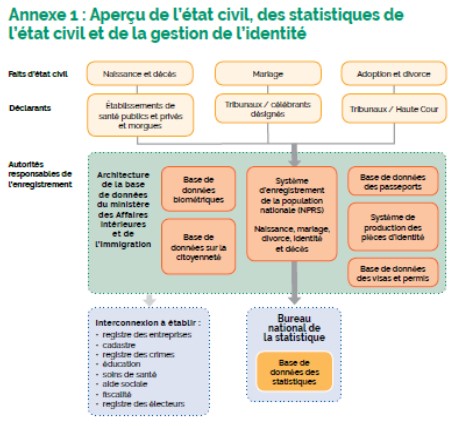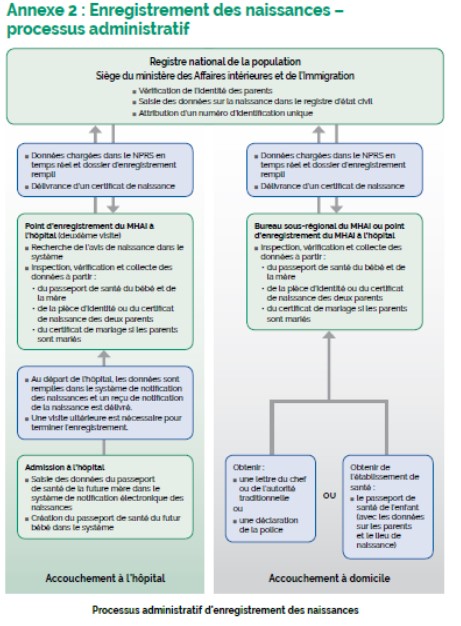Introduction
The purpose of this report is to provide a brief introduction to the civil registration and vital statistics (CRVS) system in Namibia.
The information was based on a case study of Namibia’s CRVS and identity management system, published by the International Development Research Centre (IDRC) in the Compendium of Good Practices in Linking Civil Registration and Vital Statistics (CRVS) and Identity Management Systems and supplemented by a desk review of available documents. Among other things, this report presents:
- Background information on the country;
- Selected indicators relevant to CRVS improvement;
- Stakeholders’ activities; and
- Resources available and needed to strengthen CRVS systems.
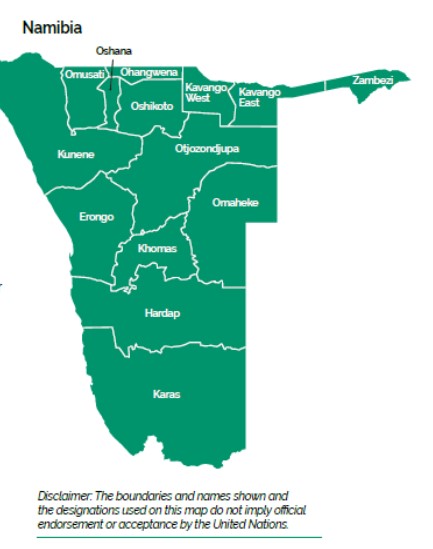
Disclaimer: The boundaries and names shown and the designations used on this map do not imply official endorsement or acceptance by the United Nations.
Country profile
The Republic of Namibia is located in Southern Africa. It borders the Atlantic Ocean to the west, South Africa to the south, Botswana to the east, and Zambia and Angola to the north. Namibia, a multiethnic nation, attained independence in March 1990. The population grew from 1.4 million in 1991 to 1.8 million in 2001 to 2.1 million in 2011.
Namibia is divided into 14 regions and subdivided into 121 constituencies.
513,015
2,324,388
1.9%
50%
CRVS Dimensions
Birth
| Completeness of birth registration |
78% (2016 |
| Children under 5 whose births were registered |
78.1% (2016 |
| Births attended by skilled health professionals |
88% (2013 |
| Women aged 15-49 who received antenatal care from a skilled provider |
81% (2007 |
| DPT1 immunization coverage among 1-year-olds |
94% (2018 |
| Crude birth rate (per 1,000 population) |
29 (2017 |
| Total fertility rate (live births per woman) |
3.4 (2017 |
| Adolescent fertility rate (per 1,000 girls aged 15-19 years) |
64 (2017 |
| Population under age 15 |
36% (2012 |
Death
| Completeness of death registration |
93.5 (2016 |
| Crude death rate (per 1,000 population) |
8 (2017 |
| Infant mortality rate (probability of dying by age 1 per 1,000 live births) |
29 (2018 |
| Under five mortality rate (probability of dying by age 5 per 1,000 live births) |
39.6 (2018 |
| Maternal mortality ratio (per 100,000 live births) |
195 (2017 |
Marriages and divorces
| Marriage registration rate |
36.5% |
| Women aged 20-24 first married or in union before age 15 |
1.6 (2013 |
| Women aged 20-24 first married or in union before age 18 |
6.9 (2013 |
| Divorce registration rate |
1% |
Vital statistics including causes of death data
| Compilation and dissemination of CR-based statistics |
Not available (N/A) |
| Medically certified causes of death data |
Not available (N/A) |
Civil registration system
Legislative Framework
In Namibia, civil registration and identification legislation is found in various laws, including:
- Article 15 of the Constitution of the Republic of Namibia, on the right to a name from birth as well as the right to acquire nationality;
- Births, Marriages and Deaths Registration Act 81 of 1963;
- Identification Act 21 of 1996;
- Marriage Act 25 of 1961 (amended in 1987);
- Aliens Act 1 of 1937, which covers change of surname; and
- United Nations Convention on the Rights of the Child, which Namibia adopted in 1990.
The purpose of the Identification Act 21 of 1996 is to provide for the compiling and maintaining of a population register for Namibia. The information is used to issue identity documents to persons who are in the population register, and for related matters.
Namibia has no comprehensive legislation on public information, electronic transactions, or data protection and privacy to allow for controlled digital data sharing. However, provisions for data protection and privacy are found in other acts, such as the Identification Act 21 of 1996. Section 14(1) provides for secrecy of information found in the population register.
The legislation for civil registration is currently under review. The new Civil Registration and Identification Bill is expected to be tabled in Parliament in 2021.
Management, organization and operations
The Department of Civil Registration, which is in the Ministry of Home Affairs, Immigration, Safety and Security (MHAISS), has two directorates:
- The Directorate of National Civil Registration is the regional arm. It is responsible for registering and issuing birth and death records and for enrolling identity.
- The Directorate of National Population Register, Identification, and Production is broadly responsible for producing identity (ID) cards, amending birth records, and registering and amending marriage records that the Magistrate Court and designated marriage officers submit.
The Ministry still works with a few magistrate courts on the registration of births and deaths. However, over the past 15 years, the Ministry has opened more offices and taken over this responsibility. Hospital-based offices were opened from 2008 to 2012 to make it easier for people to register births in a timely way. The Department often works with social protection and health authorities on these programs.
National CRVS systems coordination mechanisms
There have been notable stakeholder collaborations and partnerships on
- improving processes for birth and death registration;
- improving processes for identity management; and
- automating the vital events and identity registers.
This work is building the population register. Support also included delivering on the CRVS Comprehensive Assessment and developing a five-year strategic plan (1 April 2015 – 30 April 2020), among other things. The steering committee consists of executive directors of the relevant line ministries and heads of institutions:
- Ministry of Home Affairs, Immigration, Safety and Security (MHAISS);
- Namibia Statistics Agency (NSA);
- Ministry of Health and Social Services (MoHSS);
- Ministry of Justice;
- Office of the Prime Minister;
- Ministry of Gender Equality and Child Welfare;
- Ministry of Education;
- Ministry of Labour and Social Welfare; and
- Government Institutions Pension Fund.
Cooperation between the MHAISS and the MoHSS has been instrumental in achieving high rates of birth and death registration and ensuring timely registration. These two ministries signed a memorandum of understanding in March 2019 that covers the operations of hospital-based facilities and e-birth and e-death notification systems. Cooperation extends beyond government partners because MHAISS has also rolled out the e-birth and e-death notification systems to private hospitals.
Administrative level registration centres
Vital events are registered in the MHAISS network of 55 offices across the country:
- 14 regional offices;
- 23 hospital-based facilities; and
- 18 sub-regional offices, of which 9 offer ID card enrolment.
Accessibility of civil registration services
Most facilities are based in urban centres, near hospitals or clinics. People living in rural communities may need to travel as far as 100 km to the closest facility. Mobile units are sent to rural centres on a regular basis.
Registration of vital events
Birth registration was previously done in South West Africa based on the Births, Marriages and Deaths Registration Act 81 of 1963. The Act is still in force today. Sections 4 and 5 provide for mandatory notification and registration of births in legally prescribed timeframes and for a birth certificate to be issued free of charge. Data on the pregnant woman is collected when she is admitted to the health facility. Data is validated electronically against the National Population Registration System (NPRS). Immediately after the birth of the child, the nurse enters key birth information in the e-birth notification system; this information is sent electronically to the NPRS. The mother or both parents must return to the birth registration office to provide more information, such as the child’s name and surname, before the registration is completed.
Mandatory death registration is also done under the terms of the Births, Marriages and Deaths Registration Act 81 of 1963. Registrars or assistant registrars issue a death certificate. An online death notification system that uses the same platform as the e-birth notification system is directly linked with the NPRS. This extends the death registration process to the MoHSS and to mortuaries: it is the first official point of contact with the deceased to verify his or her identity electronically, classify the cause of death, and notify the MHAISS electronically of the death.
Civil marriages are solemnized under the Marriage Act 25 of 1961 and registered under the Births, Marriages and Deaths Registration Act 81 of 1963. Marriages can be solemnized only by marriage officers appointed by MHAISS: these are magistrates acting ex officio and some ministers of religion (mostly pastors). Registration of civil law marriage is integrated with the population register and done by the MHAISS. The Marriage Act 25 of 1961 applies only to civil marriages; it does not cover customary marriages (those performed under customary law).
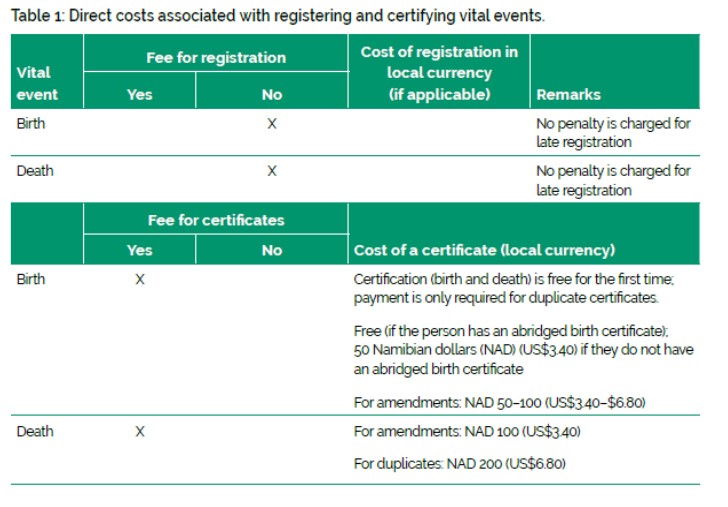
Vital statistics system
The Namibia Statistics Agency is the central statistical authority for the state and is located within the National Planning Commission for the Government of Namibia. As the civil registration authorities have achieved almost universal birth and death registration coverage, the civil register has become a key contributor to the vital statistics system. IT systems of the NSA and MHAISS have not yet been interconnected, which would allow for timely exchange of up-to-date civil registration data to ensure that vital statistics are produced for informed planning and decision-making.
The MHAISS has worked closely with the NSA since 2014 to strengthen the CRVS system. This work culminated in the drafting of a five-year CRVS strategic plan that same year.
Since 2015, the NSA, working with the MHAISS and the Office of the Prime Minister and other key stakeholders, began producing annual vital statistics reports from the NPRS administrative records. These reports provide vital statistics and evaluate the quality and completeness of civil registration data. The data quality issues are used to inform the introduction of edit controls in the NPRS system to improve the data quality. Statistics are presented at the national and subnational (including office) levels and are disaggregated by sex, age, etc. Report findings are also used to strengthen staff capacity at civil registration offices to minimize obvious errors.
Causes of death
Before the e-death notification system was introduced in 2018, the cause of death was recorded manually using a medical certificate of causes of death (MCCD) form that is not aligned to the World Health Organization standard. The medical doctor certifying a death was required to complete the MCCD form with the cause of death but was not required to do coding.
In October 2018, Namibia introduced the e-death notification system that collects information about the death and causes of death with a revised MCCD form that follows World Health Organization standards. The e-death notification system allows the medical doctors to notify a death electronically with an ICD-11 code (International Statistical Classification of Diseases and Related Health Problems, 11th revision) for the causes of death. The notification system is accessed on any Internet-connected device.
Since the introduction of e-death registration, death certificates are issued without cause of death. The MCCD can be issued by a doctor or mortuary only upon request by family. Natural deaths are handled at health facilities, while all unnatural deaths and deaths outside health facilities are handled at police mortuaries, where autopsies are carried out to determine the cause of death. Namibia does not use verbal autopsy to determine cause of death for deaths in communities. The e-death notification system feeds the e-NPRS system, which was developed by the Office of the Prime Minister and is 100 percent government owned. Namibia will release its first cause of death report based on 2016 and 2017 civil registration data in 2020.
- According to an Institute for Health Metrics and Evaluation 2016 report,
Institute for Health Metrics and Evaluation. 2016. Namibia: State of the Nation’s Health: Findings from the Global Burden of Disease. Seattle, WA. healthdata.org/sites/default/files/files/policy_report/2016/PolicyReport_Namibia_2016.pdf HIV/AIDS remains the leading cause of death and premature mortality for all ages. Up to half of all males and females aged 40–44 years who died in 2013 died of HIV/AIDS. - Tuberculosis and lower respiratory infections were the next leading causes of death and premature mortality in 2013, behind HIV/AIDS.
- Other leading causes of death for males and females changed between 2000 and 2013. For example, tuberculosis remained the second leading cause of death for both males and females, while lower respiratory infections remained the third leading cause for males and the fourth leading cause for females over the same period. Cardiovascular diseases have increased in rank for both males and females, with ischemic heart disease rising from fifth to fourth for males and from sixth to fifth for females.
Digitization
The digitizing of different business processes under the MHAISS’s responsibility was completed holistically. Rather than developing separate systems for civil registration and civil identification, a single system integrates these two responsibilities: the National Population Registration System. It links different registers using a common profile and a unique identification number (UIN).
Computerization
The NPRS is built with the civil register at its core. Every new identity in the system is created at birth by assigning unique identification numbers and adding biographical identity information that is collected when a birth is registered. That means the NPRS can function as designed only if civil registration birth records for the whole population are digitized and captured within a national database.
Computer use is outlined in Table 2.
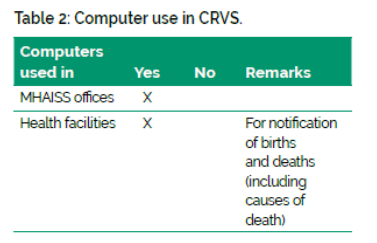
Online registration services at health facilities
Based on the memorandum of understanding with the MoHSS, the MHAISS has installed computerized systems in hospitals to run the e-birth and e-death notification software platform. This platform is used for both birth and death notifications and registrations. The MHAISS built the e-birth notification system in-house as a frontend application that is linked online to the NPRS. The system is designed to capture all relevant identity data for expectant mothers when they are admitted to the hospital before giving birth. Right after the birth and before the mother and child leave the hospital, all information relating to the birth is added to the record. The birth notification is sent to the MHAISS and a notification receipt number is issued to the mother to be presented at the civil registration office to obtain the baby’s birth certificate.
The e-birth notification system enables real-time entries and validates new entries against other existing records. In the process, the mother’s national identity (ID) card is inspected visually. These multiple points of verification were introduced to preserve the integrity of the entire system and to prevent attempts to introduce information that would allow fraudulent access to state-provided services.
The e-birth notification is used in all hospitals, and the majority of health centres, where births occur.
Following the example of the e-birth notification system, a corresponding e-death notification system has been launched at hospitals and subregional offices of the MHAISS. This approach ensures that software platforms for registering vital life events follow the same logic and platform design. In this way, there is a systematic approach to developing digitized front-office registration platforms. The system allows the MoHSS and the mortuaries, which are the first official point of contact with the deceased’s family, to verify identity electronically. The system also enables these authorities to classify causes of death and to notify the MHAISS electronically when a death has occurred. The e-death registration system has so far been rolled out to all 14 regional offices, 23 hospital-based facilities, 18 sub-regional offices, and 11 police mortuaries.
Mobile technology application
Authorized staff can use e-notification systems on their mobile devices to notify about births and deaths. All authorized system users are issued with login credentials created by authorized administrators.
Unique identification number
Under section 5(1) of the Identification Act 21 of 1996, an identity document with an assigned 11-digit unique identification number (UIN) is mandatory when a person turns 16. The format of the UIN is a logical construct based on date of birth. The UIN is linked to the birth record number, which is manually generated based on the area where the person was born and the year they were registered. This represents an organic link between birth registration, identity enrolment, and the population register. The result is an integrated approach to identity management that ensures the integrity of both the birth register and the population register. This organic link improves the integrity of functional registers connected to the population register. Data is verified against the population register through the unique birth entry number.
Population register
Namibia’s NPRS is comprehensive and interoperable. The register was created in keeping with section 2 of the Identification Act 21 of 1996, which provides for the compiling and maintaining of a population register for Namibia. The register is to include citizens and permanent residents. Section 3 of the Act lists the information to be recorded in the NPRS:
- Birth details;
- Citizenship status and/or permanent residence;
- Marital status;
- Identity document information and biometric data, such as photograph, fingerprints and palm prints; live status; departure dates from Namibia; revocation of ID cards; and any other information the Minister may prescribe by notice in the Government Gazette, including information about conditions, exceptions, or exemptions; and
- Death details.
Birth, identity, marriage, divorce, and death records in the NPRS are interlinked with children’s and parents’ records. Spouses’ records are linked to one another. This means that marital status is updated automatically in the event of divorce or the death of one spouse. This approach has built a family tree over time.
Digitization of historical registration records
Until 2011, only data needed for issuance of ID cards was available in a digital format. To address the lack of digital data before 2011, the MHAISS began to digitize paper civil registration records from the 1980s to 2012. The paper archive of some 4.5 million birth records has been digitized using M-files records management software. These birth records are kept in a dedicated M-files database: they are added to the NPRS only after a person applies for a duplicate or an amendment and after more verifications are done.
The M-files database is designed to store a large number of scanned documents in a single database. The information in the database is organized using tags that link to a specific scanned document. During the scanning process, each record is tagged with a critical set of identity and vital event information that corresponds to the information on the scanned paper. Tags are kept in a separate searchable database that links to individual scanned records. The marriage and death records are scanned and captured directly in the NPRS. Birth records cannot be uploaded to the new digitized NPRS because the birth records and ID records did not have a unique identifier.
Link with the identification system
Today, Namibia does identity management based on the Identification Act 21 of 1996. The Act combines identity management with a population register at a process level, treating identity management as a key part of the NPRS. As a result, identity cards are legally issued directly from the NPRS. Unlike in other countries, there is no distinct identity management system. A person has one main profile in the NPRS with different modules — such as birth, marriage, identity, and death. These are connected organically to the NPRS with a unique and confidential reference number. Namibia issues ID cards to both citizens and non-citizens who are permanent residents or refugees.
Also, the Identification Act 21 of 1996 provides for the collection of biometrics for identity enrolments at age 16. Biometrics underpin the uniqueness of identity and bind identities to specific identity holders. Proof of identity is key to maintaining a robust national population register and upholding data integrity. This also ensures that documents such as birth and death certificates, identity cards, and passport and travel documents are trustworthy. In turn, population data integrity means that linked functional registers are accurate.
Interface with other sectors and operations
Through the interoperability framework, managed by the Office of the Prime Minister, NPRS data could in future be shared electronically with other agencies when a legal framework is in place. At the moment, in accordance with the Identification Act, MHAISS shares information with government offices, ministries, and agencies. Three systems are linked to the NPRS:
- e-Birth and e-death notification system;
- Passport system; and
- NPRS Web Service platform, which was established in 2018 as an external interface for identity validation and has the following functions:
- Exchanges master reference data between institutions and offices;
- Validates national ID credential data; and
- Validates birth certificates.
The NPRS can support the online services that are planned under the Namibia eGovernment project. The NPRS has the capability and potential for further links with functional registers within government and in the private sector.
The electoral management system makes it possible for Namibian citizens to register and to vote in local, regional, and national elections under the Electoral Act 5 of 2014. It is critical to verify citizenship to determine eligibility to register as a voter. Additionally, personal data such as name and surname, age, and live status must be verified on the NPRS to facilitate voter registration and actual voting. The Ministry has electronic data on deaths to validate the voter roll, as required by the Electoral Act 5 of 2014.
Sample registration forms
Improvement initiatives and external support
Improvement plan and budget
Strategic plan
The CRVS strategic plan outlines the approach and direction to improve CRVS in Namibia. The plan provides an integrated picture of how the CRVS system would be developed over five years, starting in 2015. It demonstrates the themes, objectives, initiatives, and allocation of resources in response to CRVS opportunities and challenges. This strategic plan forms the basis for performance management, to be conducted formally on a quarterly basis. Fifteen strategic objectives are to be achieved by taking the following actions in five thematic areas:
- Lay the legislative and administrative foundation by:
- reforming existing legislation and policies and developing new ones;
- ensuring coordinated structures and strong leadership; and
- securing a sufficient number of staff with the right set of skills.
- Improve efficiency by improving business processes and use of technology.
- Improve civil registration data by:
- working toward increasing demand and understanding of CRVS by the public and partners;
- improving access to equipped civil registration service points;
- ensuring timely birth, death, marriage, and divorce registration;
- improving recording of cause-of-death information;
- maintaining and further enhancing the NPRS/civil registration system; and
- strengthening quality assurance and data validation.
- Strengthen identity and rights.
- Improve quality and timeliness of vital statistics.
Budgetary allocations and requirements
The total budget toward the approved five-year strategic plan was approximately 243 million NAD (US$16.3 million). The average total annual amount required to implement all initiatives in all themes was almost 50 million NAD (US$3.3 million). To date, the government has provided most of the funding to implement the strategic plan.
Activities identified as high priorities
The CRVS activities identified as high priorities are in Table 3.

Support from development partners
The development partners that provided support to Namibia’s CRVS systems improvement initiative are listed in Table 4.

Additional Materials
Websites
Additional materials
Centre of Excellence for Civil Registration and Vital Statistics (CRVS) Systems. 2020. The Nexus Between Civil Registration and Social Protection Systems: Five Country Practices. Namibia Case Study. International Development Research Centre, Ottawa, ON. crvssystems.ca/sites/default/files/assets/files/SocialProtection_3_Namibia_e_WEB.pdf
Institute for Health Metrics and Evaluation. 2016. Namibia. State of the Nation’s Health: Findings from the Global Burden of Disease. World Health Organization (WHO). Namibia. healthdata.org/sites/default/files/files/policy_report/2016/PolicyReport_Namibia_2016.pdf
Ministry of Home Affairs and Immigration and Namibia Statistics Agency. 2015. Strategic Plan 2015/16–2020/21 for the Civil Registration and Vital Statistics System in Namibia. cms.my.na/assets/documents/CRVS_Strategic_Plan_Final.pdf
Namibia Statistics Agency. 2017. Namibia Intercensal Demographic Survey: 2016 Report. cms.my.na/assets/documents/NIDS_2016.pdf
Centre of Excellence for Civil Registration and Vital Statistics (CRVS) Systems. 2019. Compendium of Good Practices in Linking Civil Registration and Vital Statistics (CRVS) and Identity Management Systems. Namibia Case Study. International Development Research Centre, Ottawa, ON. crvssystems.ca/sites/default/files/assets/files/CRVS_Namibia_e_WEB.pdf
Ministry of Home Affairs and Immigration and Namibia Statistics Agency. 2015. Comprehensive Assessment of the Civil Registration and Vital Statistics System in Namibia. July–October 2014. d3rp5jatom3eyn.cloudfront.net/cms/assets/documents/CRVS_Comprehensive_Assessment_Report_Final.pdf
World Bank. 2016. ID4D Country Diagnostic: Namibia. Washington, DC: World Bank License: Creative Commons Attribution 3.0 IGO (CC BY 3.0 IGO). documents.worldbank.org/curated/en/922381468196196254/pdf/Namibia-ID4DDiagnostic-WebV042018.pdf
Conclusion
Namibia has a sound nationwide administrative and decentralized institutional framework in place in regional offices, health facilities, magistrate courts, and police offices. This framework brings services to the people, enabling efficient civil registrations and ID card enrolment. It is also behind the rollout of the country’s e-birth and e-death notification systems.
Namibia’s civil registration and identity system is further reinforced by strong government leadership on the value of strong systems. This led to the country building a homegrown national population register with internal resources. The country has achieved improved customer service and efficient service delivery by restructuring its identity management business processes. Although there are still newborn children who are not registered in a timely manner, an almost complete birth registration is a critical base of the NPRS. Death registration allows for timely updates on the live status of individuals, which promotes good data integrity. Complete registration of marriages and divorces is critical for updating the marriage status of individuals and completing personal profiles for children born of the marriage. The NPRS is a solid infrastructure that is ready to take on linkages with functional registers as required, both within government and with registers in the private sector.
Endnotes
[footnotes]
Annex
